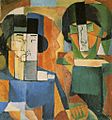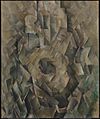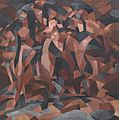Cubism facts for kids
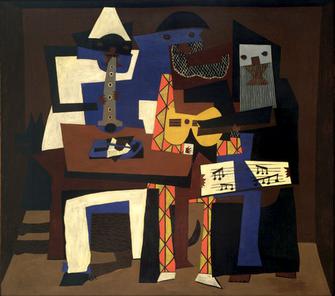
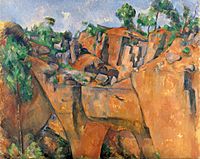
Cubism was a super important art style in the 1900s. It started in France around 1907. This new way of painting really took off from 1910 to the 1920s. Two artists, Georges Braque and Pablo Picasso, were the main creators of Cubism.
One of the first Cubist artworks was Pablo Picasso's painting Les Demoiselles d'Avignon from 1907. In 1908, Georges Braque painted Houses at L’Estaque. A art critic named Louis Vauxcelles saw these paintings and called them "cubic oddities." This is where the name "Cubism" came from!
The first big art show for Cubist artists happened in Paris in 1911. Artists like Jean Metzinger, Albert Gleizes, and Fernand Léger showed their work. Interestingly, Picasso and Braque did not show their art at this first group exhibition.
Art historians often divide Cubism into three main periods. The first was "Early Cubism," from 1906 to 1908. This is when Picasso and Braque first came up with the style. Then came "High Cubism," from 1909 to 1914. During this time, Juan Gris became another important Cubist artist. The last period was "Late Cubism," from 1914 to 1921. This was the final stage of Cubism as a brand new and exciting art movement.
What is Cubism?
Cubism is an art style that tries to show all the different sides of a person or an object at the same time. Imagine looking at something from the front, side, and back all at once! The artworks often look like they are made from cubes and other geometric shapes. This is why it's called Cubism.
Analytical Cubism
The first type of Cubism was called Analytical Cubism. Artists who used this style often painted with only one color, like shades of gray or brown. They did this so that people looking at the painting would focus on the shapes and forms, not on the colors. It was like they were "analyzing" the object by breaking it down into many parts.
Synthetic Cubism and Collage
Things changed in 1912 when Picasso started using colors in his Cubist paintings. He also began using something new called collage. Collage is when you glue different pieces of paper or other materials onto a canvas to create an artwork. Picasso invented collage because he wanted to try new ways of making art. This new style of Cubism, which used color and collage, was called Synthetic Cubism. Pablo Picasso created more than 20,000 artworks in his life! His Synthetic Cubism period lasted from 1912 to 1919.
Images for kids
-
Albert Gleizes, Man on a Balcony, 1912.
-
Robert Delaunay, Simultaneous Windows on the City, 1912, an example of Abstract Cubism.
-
Paul Cézanne, Quarry Bibémus, 1898–1900.
-
Diego Rivera, Portrait of Messrs. Kawashima and Foujita, 1914.
-
Le Corbusier, Assembly building, Chandigarh, India.
-
Le Corbusier, Centre Le Corbusier (Heidi Weber Museum) in Zürich.
-
House of the Black Madonna in Prague, built in 1912.
-
Georges Braque, La guitare (The Mandora), 1909–10.
-
Albert Gleizes, Woman with Phlox, 1910.
-
Georges Braque, Violin and Candlestick, 1910.
-
Robert Delaunay, The City No. 2, 1910–11.
-
Marcel Duchamp, The Sonata, 1911.
-
Fernand Léger, The Smokers, 1911–1912.
-
Georges Braque, Man with a Guitar, 1911–12.
-
Jacques Villon, Girl at the Piano, 1912.
-
Francis Picabia, The Spring, 1912.
-
Albert Gleizes, Football Players, 1912–13.
-
Juan Gris, Still Life with Checked Tablecloth, 1915.
-
Diego Rivera, Portrait of Ramón Gómez de la Serna, 1915.
-
Juan Gris, Portrait of Josette, 1916.
-
Gino Severini, The Accordion Player, 1919.
-
Albert Gleizes, Woman with Black Glove, 1920.
See also
 In Spanish: Cubismo para niños
In Spanish: Cubismo para niños









